The stinzenplanten lawn (also known as a stinzen garden or more simply a stinze) is a naturalized and wild bulb garden that secretly lives under your lawn and emerges, beautifully, in the earliest spring. And then it retreats just as the rest of your garden is starting to wake up. For 10 months out of the year, you don’t even know it is there. A Stinzen garden makes mud season less mucky and gives gardeners some colorful pretty just when they usually start to think the world has turned permanently sepia. I’ve planted a couple of them in my own yard over the last few years and they are easily the best new things in my garden.
The name- stinzenplanten – is Dutch, because of course, the country famous for their bulbs and plants, created it. The term “stinzenplanten” originates from the Dutch word “stinzen,” which refers to large old country houses and historical estates and parks in the Netherlands. These homes are often surrounded by large lawns that have been underplanted with a vibrant and colorful display display of small early spring bulbs. During the spring season they attract visitors who appreciate the natural beauty and the historical significance they represent.
These Dutch naturalized gardens – or bulb lawns are easy to install and maintain, they radically extend the season of color and liveliness in your yard, and they take you one giant step closer to making your lawn a little bit less of an ecological burden and a more of a vibrant early spring place of beauty and life.
When to plant your Stinze bulb lawn?
A stinze garden commonly feature a mix of bulbs, such as daffodils, crocuses, and snowdrops, and are typically found in historical estates and parks throughout the Netherlands.
Spring bulb planting season is short and it is in the fall. You will typically have a couple months to order and plant your stinzen garden.
The first frost here in New England is typically in October – but could be as early as late september and the ground and the ground might freeze by the end of November. After that – you’ve missed your window.
You can start ordering your bulbs in late summer and suppliers will mail them to you when the time is right for planting. If you want the best selection (bulbs are always in limited quantities and the trendiest and most stalwart performers always sell out first) put a reminder in your calendar to make your orders by the end of August.
But don’t fret if you are just getting to this in October – you will still be able to get bulbs – and you can add whatever you might have missed out on next year.
How I installed my own Stinzenplanten:
I chose an area at the top of my driveway and around my apple tree. The tree is situated straight out my front door and is a place I see every morning when I take Bullet (the dog) out for his morning ablutions.
When I told my husband what I was doing (which involved temporarily peeling back layers of turf) I got the expected – “Stinzen-what?”
If you have a husband who is inclined to freak out when he sees you with a shovel in the lawn – here is your the script for what you need to say:
“A Stinzenplanten (that’s Dutch) is a lawn that is underplanted with an early spring succession of naturalized flower bulbs. It’s typical of stately 19th-century brick homes in the Netherlands. (You can totally imply that your stinze will make your home seem like the swish-est on the block). This bulbs will come out before the grass has greened and be gone before you start mowing…Breathe Honey…your precious perfect lawn will still be precious and perfect… but just better because it will be prettier sooner – but without you doing anything more. Breathe…” .
– You (with a very calm and confident tone)
Then you pat him on the head and go for it.
What is in a stinzen garden?
A stinzen style garden typically features Crocus, Chionodoxa, Ornithogalum, leucojum or galanthus (snowdrops), Hyacinthoides non-scripta (english bluebells), Tulipa sylvestris and narcissus (daffodils) and other various early blooming bulbs.
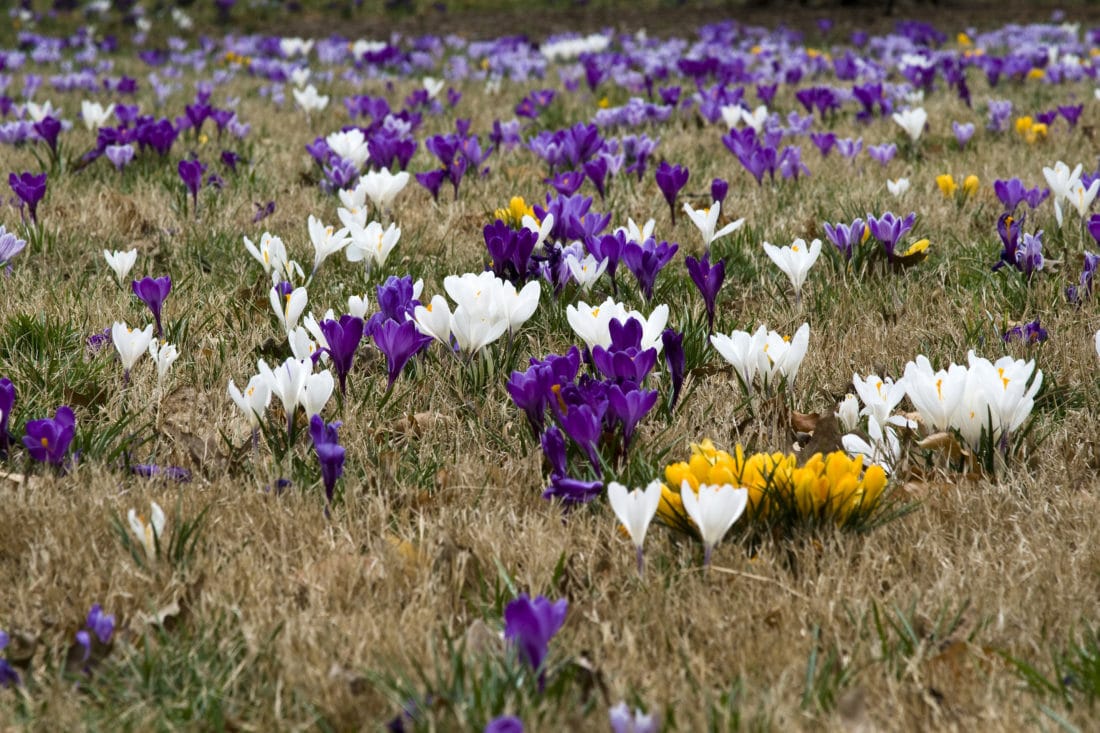
A Stinzen style lawn will improve with time (as the bulbs naturalize – which is to say, they reproduce naturally – making more bulbs and visually filling in gaps over time). It is great for areas of your garden that may only get sun before the trees leaf out.
That is why I choose to put mine under the apple tree. It gets a bit shady later in the year.
If you want to try the same – here are my tips for planting a bulb lawn:
Choose the right kind of bulbs for a Stinzenplanten
Part of the goal is to make your lawn interesting even before it becomes its most interesting.
(Seriously though – do lawns ever really become interesting? They are brown and then they are green – so boring! if you really think about it)
But if you plant right, you can really jazz up a lawn and instead of the standard (yawn) brown to green transformation. You can go from brown, to brown with specs and swaths of very early spring color (purple, white, yellow), to brown-green with specks and swathes of other early spring colors (more yellow, purple and while, but also maybe blues, reds, and pinks), to green with specks and swaths of mid spring color (that can even include checkerboard patterned flowers!).
This is a solid 6+ weeks of fun at a time of year when literally nothing else is happening and personally, I’m most desperate for the brown winter to fade away.
And (BONUS!) you can choose your bulbs so that the colors kaleidoscope together as they shift from one bloom to the next.
Mine starts with white and yellow, then fades into blue and purple with specks of white and yellow, and then goes to new shades of purple punctuated with bell shapes flowers that are literally decorated pink checkerboards.
(Checkerboard. printed. plants. – otherwise known as fritillaria – If that isn’t jazzy… then I don’t know what is).
A Bulb Lawn Break Down for a New England (zone 5-6) Garden
The key to a stinzenplanten lawn is picking a range bulbs that not only work in your area (zone wise) but that bloom over at least three seasons. The seasons: Very Early spring. Early spring. And Mid spring. Each season is 2-2.5 weeks long.
I advise sticking to these earliest seasons because if you go later, then you will be more likely to want to cut the grass – and thus the foliage and flowers of the bulbs too soon.
For my Stizenplanten I have this break down of varieties:
Very Early spring bulbs:
Galanthus woronowii (early snowdrops)
Galanthus woronowii, commonly known as early snowdrops, are a delicate and charming perennial bulb that heralds the arrival of spring with its graceful, pendulous white blossoms. The flowers will often emerge through a blanket of snow, earning their name as one of the earliest harbingers of the season’s renewal.
I love them – but if you live in an area that gets heavy snow – you might not want to bother with these. Here in New England, I rarely see them. I think they are blooming under the still too thick snow.
What sets Galanthus woronowii apart are its distinctive green markings on the inner petals, adding a touch of elegance to its snowy appearance. These dainty flowers are celebrated for their resilience and ability to thrive in woodland settings, garden borders and under your lawn.
Eranthis cilicica (winter aconite)
Eranthis cilicica, commonly known as winter aconite, is a petite yet captivating perennial plant that bursts into bloom during the late winter or early spring. This charming early harbinger of spring stands out with its bright yellow, cup-shaped flowers, which appear even before its leaves fully unfurl. Winter aconite is celebrated for its ability to thrive in cold and often inhospitable conditions. The plant is also known for its toxin, eranthin, which can deter herbivores from grazing on it (Be Gone, you munchy Deer!!), showcasing its clever survival strategies. Winter aconite can carpet woodland floors or naturalize in meadows, bringing a vibrant splash of color to the still-sleeping landscape.

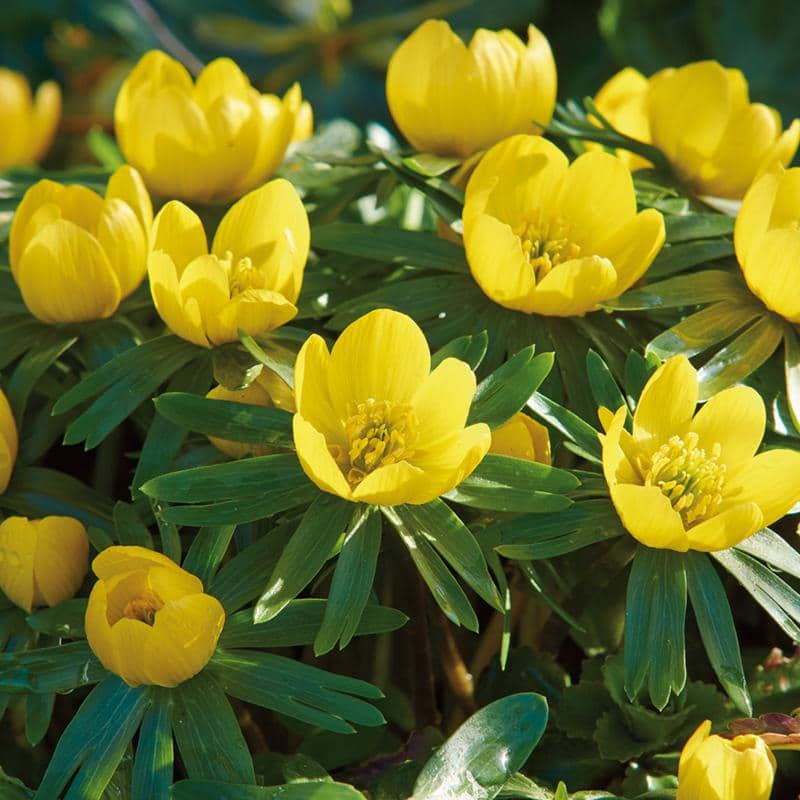
Early Spring:
Chiondoxa forbesii (Snow Glories)
Chionodoxa forbesii, commonly known as Snow Glories, are a charming spring-blooming bulbous plant that enchants with its delicate, star-shaped flowers. These dainty blossoms come in shades of pale blue to lavender, and their vibrant yellow centers provide a striking contrast. Snow Glories emerge in early spring, also, often before the snow has completely melted. Chiondaxa naturalize readily, forming large drifts of carpet-like flowers over time. Snow Glories are low-maintenance and thrive in a variety of garden settings, from woodland borders to rock gardens.
Scilla siberica (Siberian Squill)
Scilla siberica is a delightful (and one of my favorites) spring-flowering bulb that blankets gardens with a profusion of small, star-shaped, deep blue or violet-blue nodding flowers. These dainty blooms, like all the other stizenplanten bulbs, create tapestry of color as they naturalize and spread. Siberian Squill is native to Eastern Europe and Asia but has found its way into gardens around the world. It can thrive in both sunny and partially shaded areas, making it a versatile addition to various garden settings. This resilient bulb is known for its ability to endure extremely cold temperatures. Siberian Squill will self-sow and naturalize, adding a touch of elegance to lawns, woodland gardens, rockeries, and borders.
Giant Crocus
Giant Crocus, scientifically known as Crocus vernus, is a striking spring-flowering bulbous plant that boasts larger and more flamboyant blossoms compared to its smaller crocus relatives. These vibrant flowers appear in an array of shades, including deep purples, bright yellows, and rich blues, creating a stunning display in early spring.
My favorite are the white ones with purple pinstripes. (so fashionable!) Buy a mixed bag and you will get plenty of variety.
What sets the Giant Crocus apart is its commanding presence and ability to make a bold statement in the garden. The flush of colors will intensify when the crocus emerge.
You can also choose regular crocus (referred to as species crocus) and will enjoy slightly earlier blooms that are a little bit smaller. (But equally worthwhile).
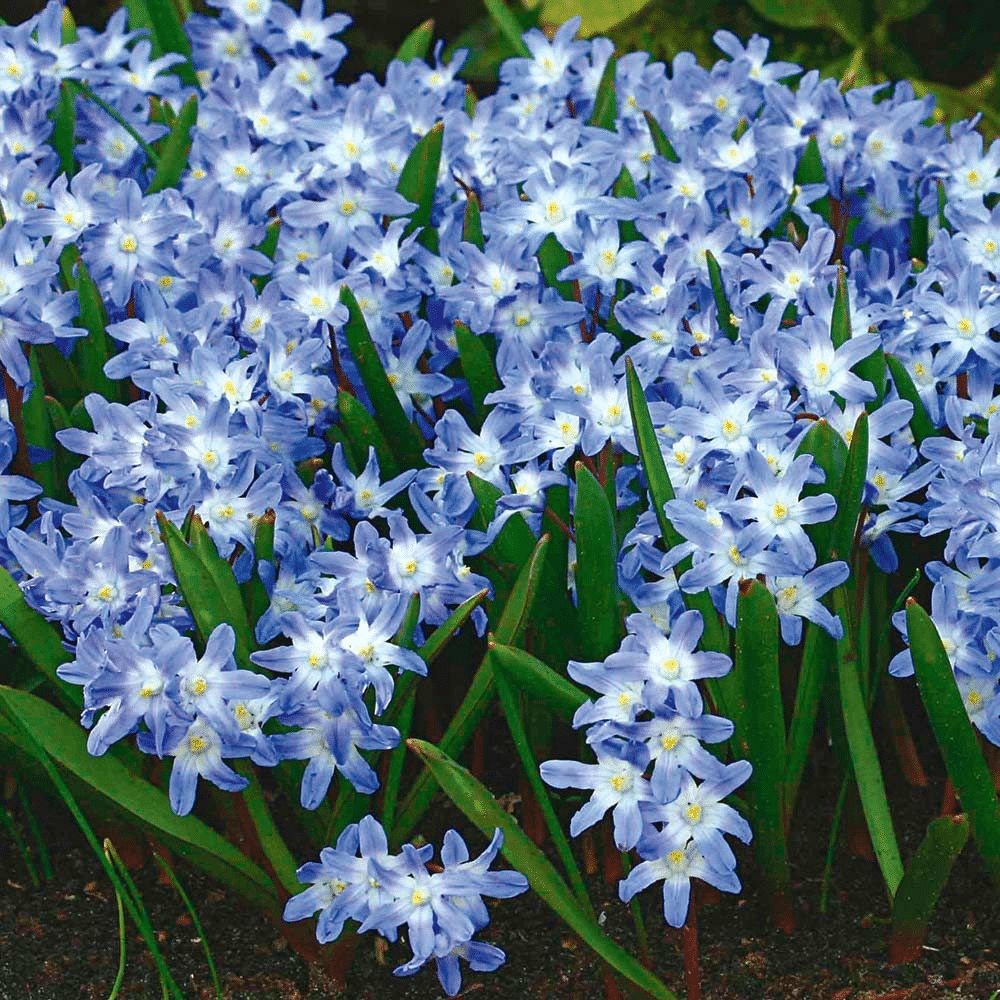
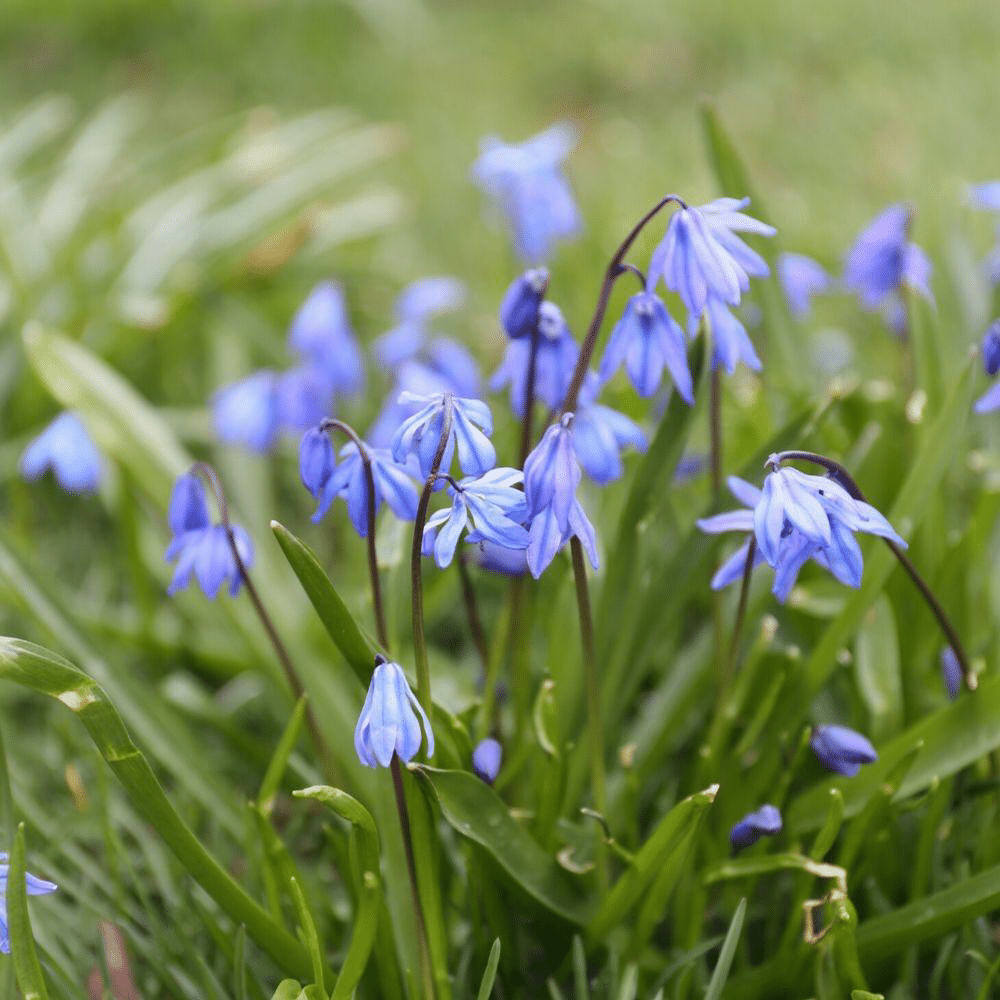
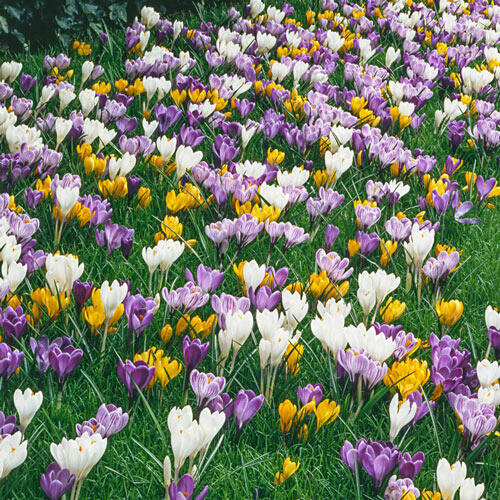
Early – Mid Spring:
Blue Shades Anemone
Blue Shades Anemone, scientifically known as Anemone blanda ‘Blue Shades,’ enchants with its profusion of vibrant blue blossoms. They look like daisies, with bright blue petals and golden centers. Thriving in both full sun and partial shade, they are versatile. I like them because they don’t look like your typical bulb flowers. They are wilder and looser and an excellent textural contrast to all the other blooms.
Fritillaria meleagris
Fritillaria meleagris, commonly known as the Snake’s Head Fritillary or Checkered Lily, is a captivating spring-flowering bulbous plant. This distinctive flower has a unique and intricate pattern unlike any other flower you’ve ever seen. The petals sport a checkerboard in shades of purple, pink, or white, often with hints of burgundy or maroon. Its drooping, bell-shaped blooms also are taller than anything else in this mix. Where all the other flowers I’ve mentioned are less than 7 inches tall, Fritllaria meleagris flowers will stand above at 10-12 inches high. They are tall enough and profuse enough that I can cut them for bouquets and still have plenty in the landscape. After the blooms fade, their remaining seed pots also make great textural additions to later spring arrangements.
Fritillaria are native to Europe, and have regularly been noted in art, literature and folklore as far back as ancient Greece.
Snake’s Head Fritillary like to naturalize in damp meadows or alongside water features. But even without a water feature, they have also been very happy in my lawn (it is not particularly wet).
Grape Hyacinth
Grape Hyacinth, scientifically known as Muscari, is known for its unique, grape-like clusters of flowers. These small, bell-shaped blossoms come in various shades of blue, purple, and white, resembling a bunch of miniature grapes when in full bloom. Grape Hyacinth (along with fritillaria) add a touch of whimsy. They are great for creating carpets of purple beneath trees, in borders and the stinzen garden, and along pathways. Many of these early blooming bulbs do not have a fragrance but grape hyacinths carry a sweet scent.


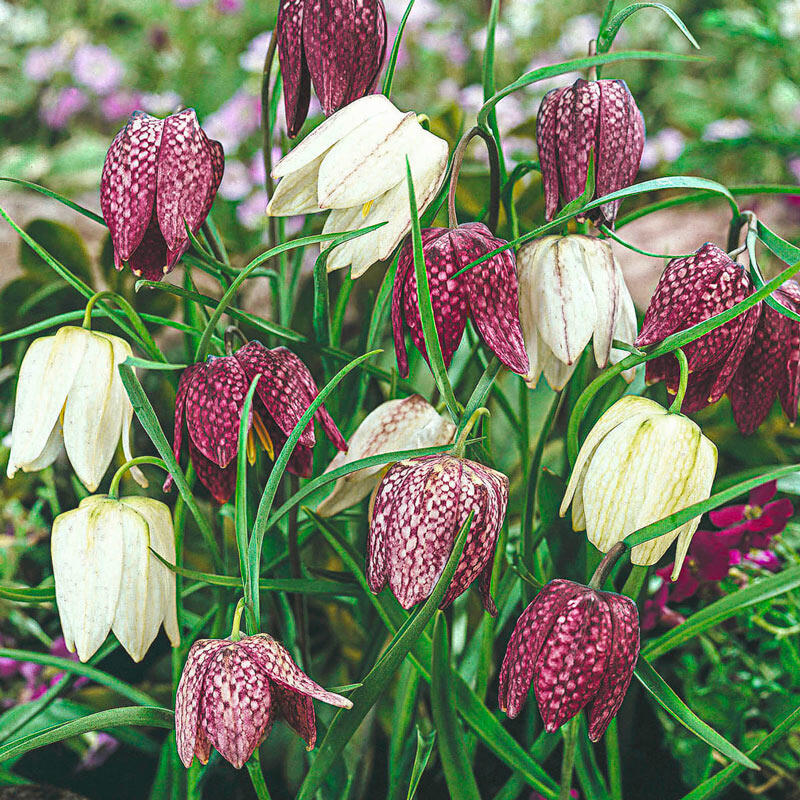
Choose a place where you are going to really enjoy the stinzenplanten lawn’s spring display.
I briefly considered planting up a stinze on the hillside on the far side of my lawn. But in reality, there is a decent chance that I won’t enjoy it because it requires me to trek through snow to see it.
Instead, I’ve opted for the area at the top of my driveway where I’ll see my stinzenplanten lawn all the time. It’s a sunny spot – particularly in the spring before the trees leaf out. To make it even better, it is centered beneath an apple tree.
Stinze planted gardens are great for that area under trees where nothing else (not even grass) grows. You can carefully plant the bulbs between the roots and actually grow something interesting in the area where lawns can struggle.
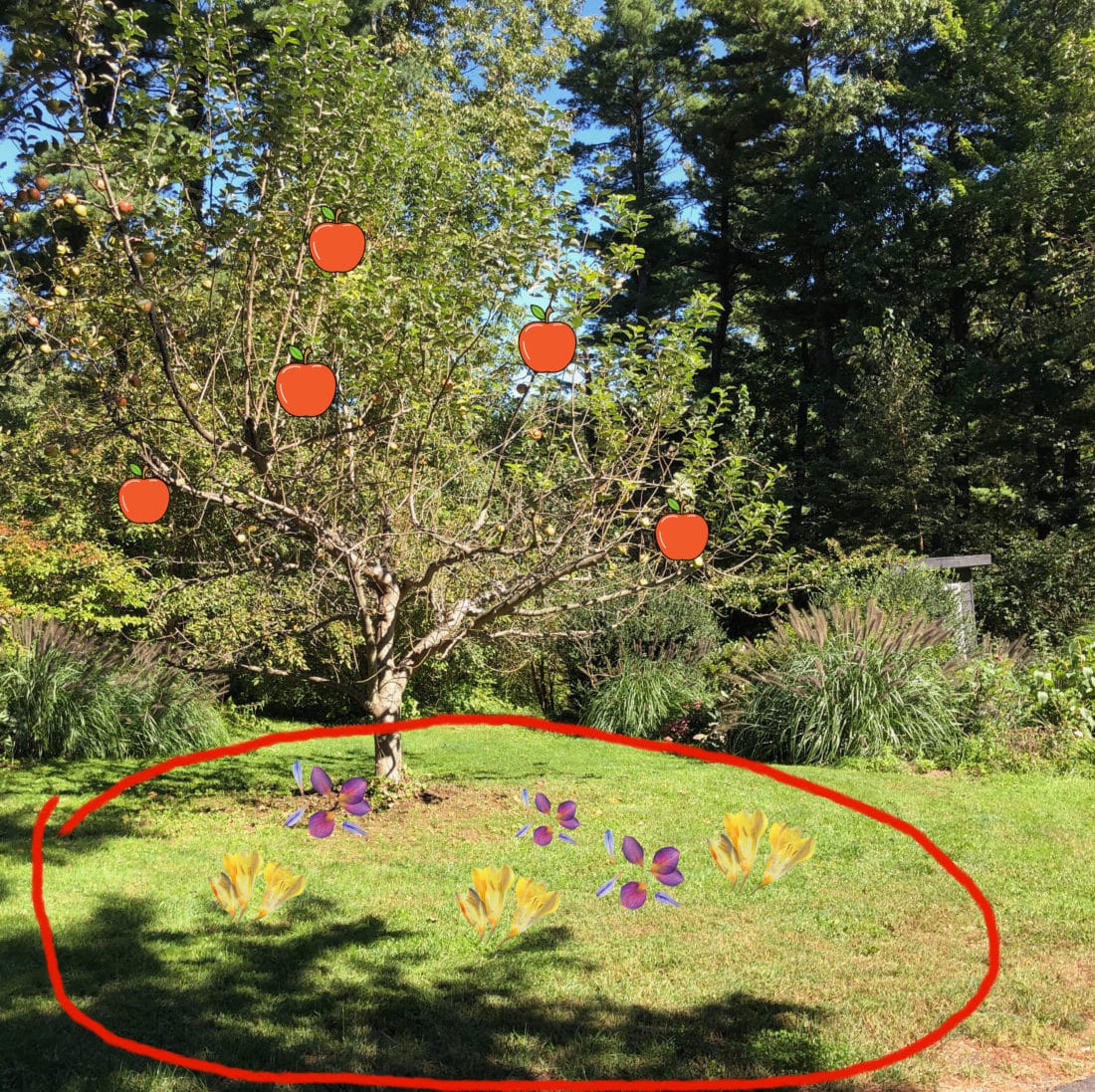
Add an additional layer of design if you can.
I planted my bulbs in a defined circle around a tree – but here is another whimsical idea from @mettebfauerskov for laying out your stinzenplanten lawn.
Use a hose to give yourself a guide and create swirling lines or a secret path.
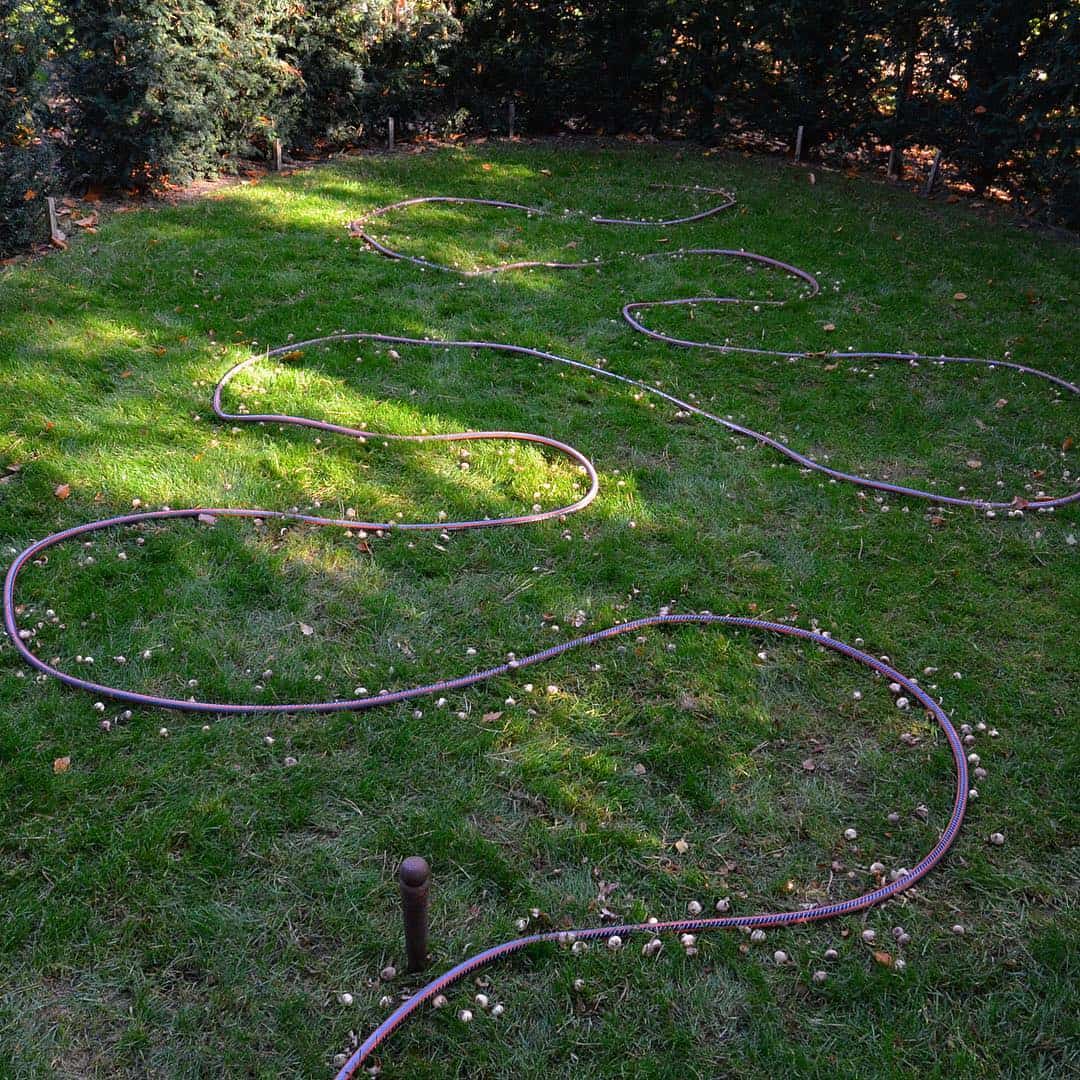
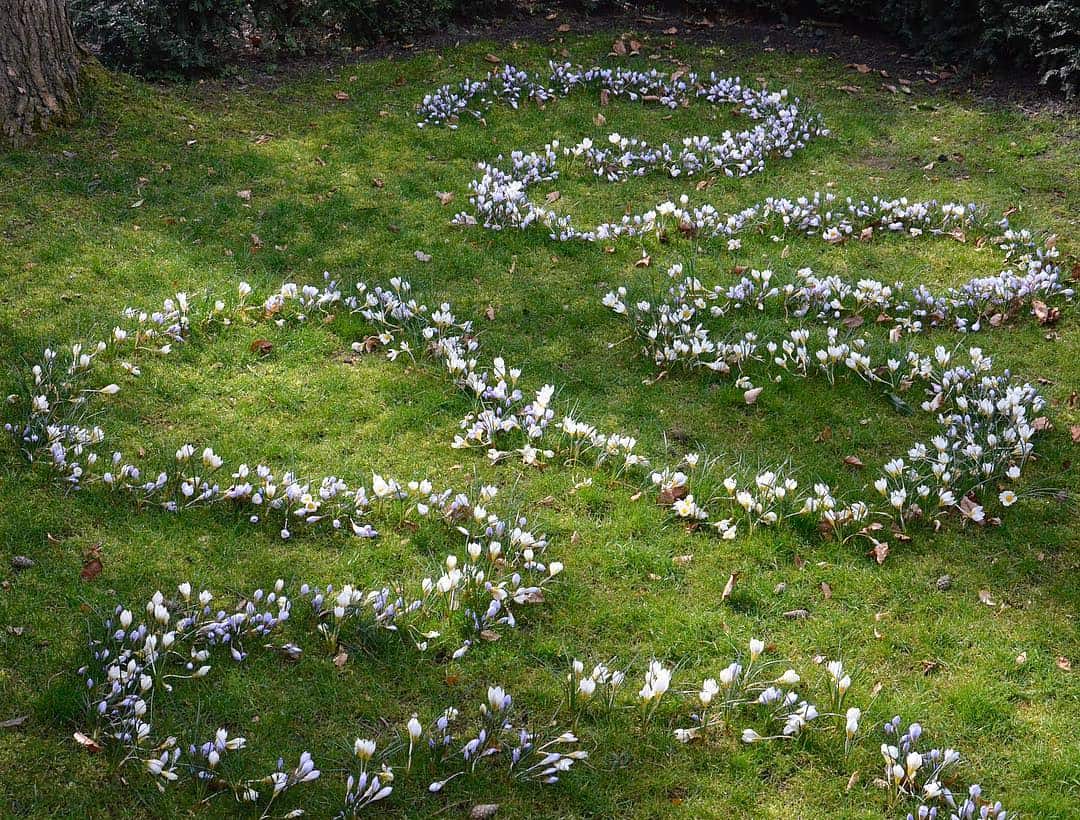
How to make your stinzenplanten lawn less chaotic with design
It can be nice to just mix all your bulbs up randomly and plant them throughout your lawn – but I think it will look better if I aim to give it a more cultivated appeal.
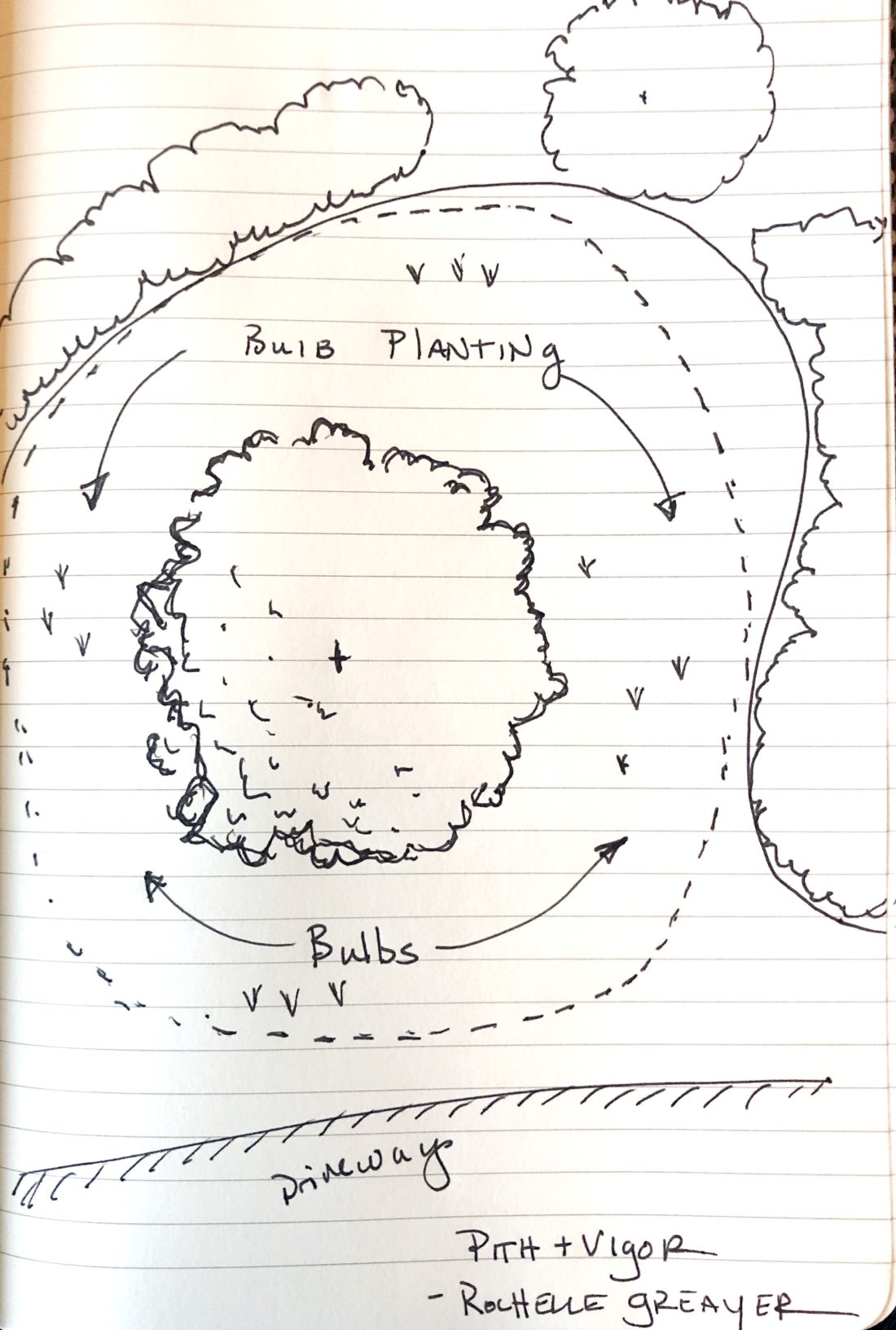
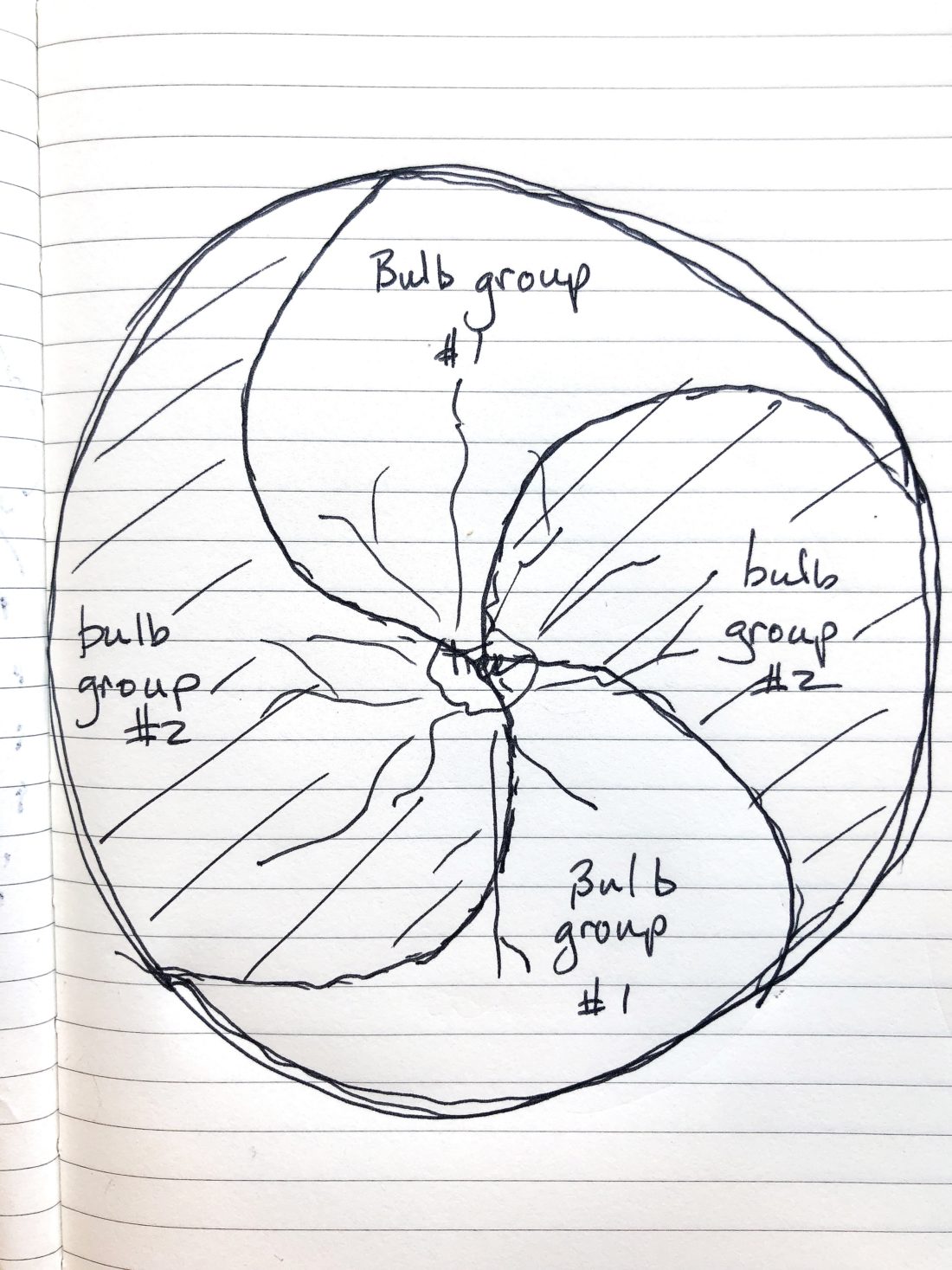
I’m defined an edge to my planting. It is invisible most of the year, but is obvious when the bulbs are out. The planting is a proper and distinct circular shape (you can see in my sketch above).
I highlight the circle even further by mowing around the edges. This creates a distinct circle of longer grass and bulbs next to a cleaner cut bulb free grass.
I also took advice from my friend and fellow designer Carrie Preston. She created the award winning Stinze Garden for the 2017 Philadelphia flower show. (Where one of the main concepts of that garden was this same type of naturalized bulb planting).
Making Bulb Sub-groups for a better naturalization
She suggested finding a way to group bulbs but not in a way that diminishes from the natural slightly wild look but to heighten it. So, instead of mixing all the bulbs together, I split the selection in half. I made sure that each half had at least one variety of bulb that blooms in each season.
Additionally, I broke my circle into 4 quadrants (with a twist – see above right) and scattered the bulbs within just the quadrants. When I planted, I put at least a half dozen bulbs of the same variety in each hole. The end result is the bulbs are scattered, but still planted to give nice clumps. And there is a a greater clustered and wave effect of certain colors in certain areas. Basically it looks perfectly wild not chaotic wild. (BTW – nature is not actually chaotic and random. It is quite orderly and this method simulates more closely how these bulbs might look after having naturalized for generations)
Here are my stinzenplanten Bulb Groupings:
Bulb group #1 is:
Galanthus woronowii (early snowdrops) – Chiondoxa forbesii – (Snow Glories)- Giant Crocus – Blue Shades Anemone – Fritillaria meleagris
And bulb group #2 is:
Eranthis cilicica (winter aconite) – Scilla siberica – (Siberian Squill)- Grape Hyacinth
Most Importantly – Plant the Stinzenplanten Lawn Bulbs in the Fall (before it gets too cold!)
If you would like to see how this garden turned out – as well as subsequent additional stinzenplanted gardens I’ve added (because, yes, they are that great!) – check out these posts:
This post is sponsored by flowerbulbs.com
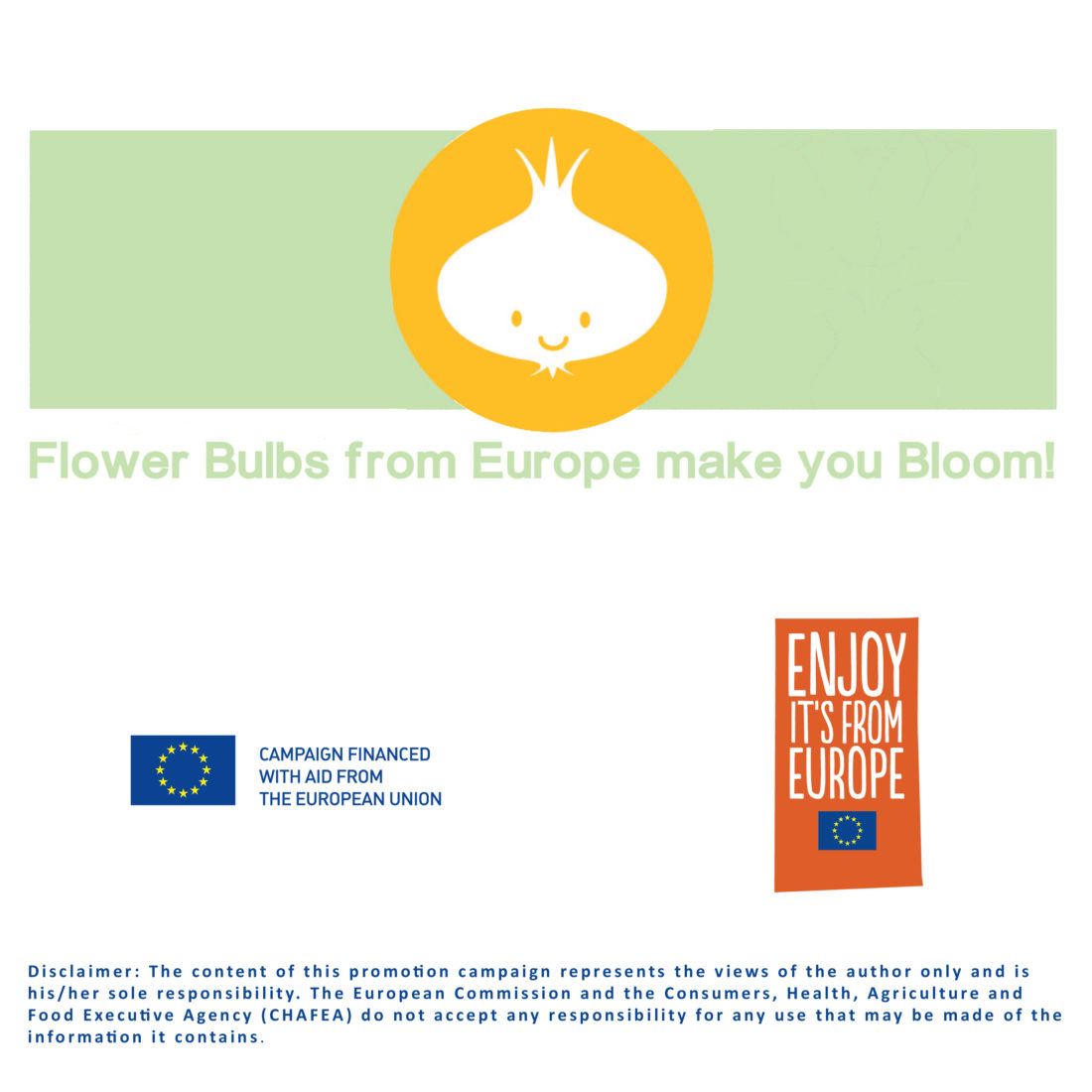
I am trying to do the same, inspired by some neighborhood lawns with old naturalized crocus plantings. I’m also incorporating (or trying) the native claytonia virginica. A nearby neighborhood has a large oak dominated island that has a carpet of Virginia spring beauty flowers in March. I would love to develop the same. I’ll know how my 500+ bulbs turn out in a few months!
I stumbled upon this post and now I would love to see how it turned out in the promised update from Spring 2022. I have searched for it and signed up for some of your classes but still haven’t found the follow-up to stinzen planting.
Hi Rose- it tournedc out great! relaly one of my favorite things from this garden year. I posted a bunch of images on my instagram this spring (@pithandvigor) that you can see and I am working on more about it (since I am planting a second area in my garden in this style) right now. It was so good, I’m doing it again. 😉